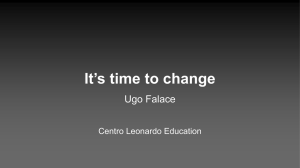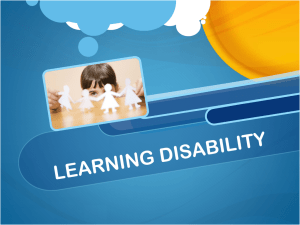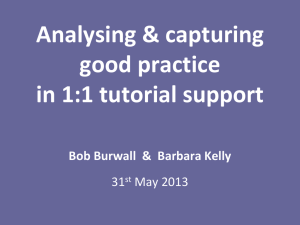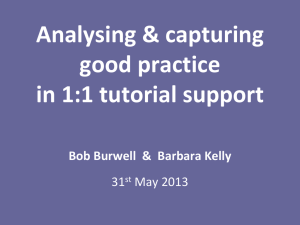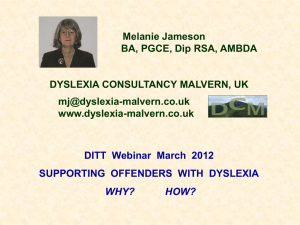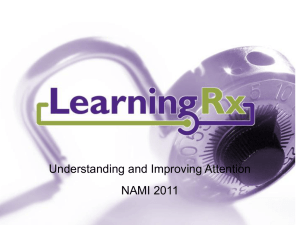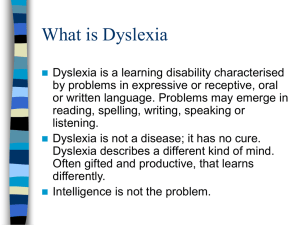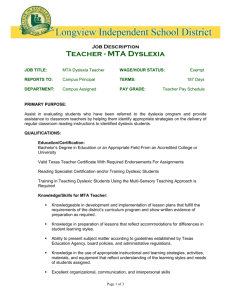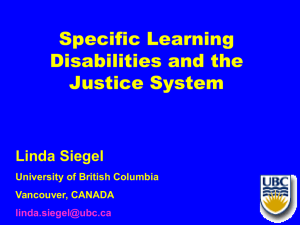2-page proposal file
advertisement
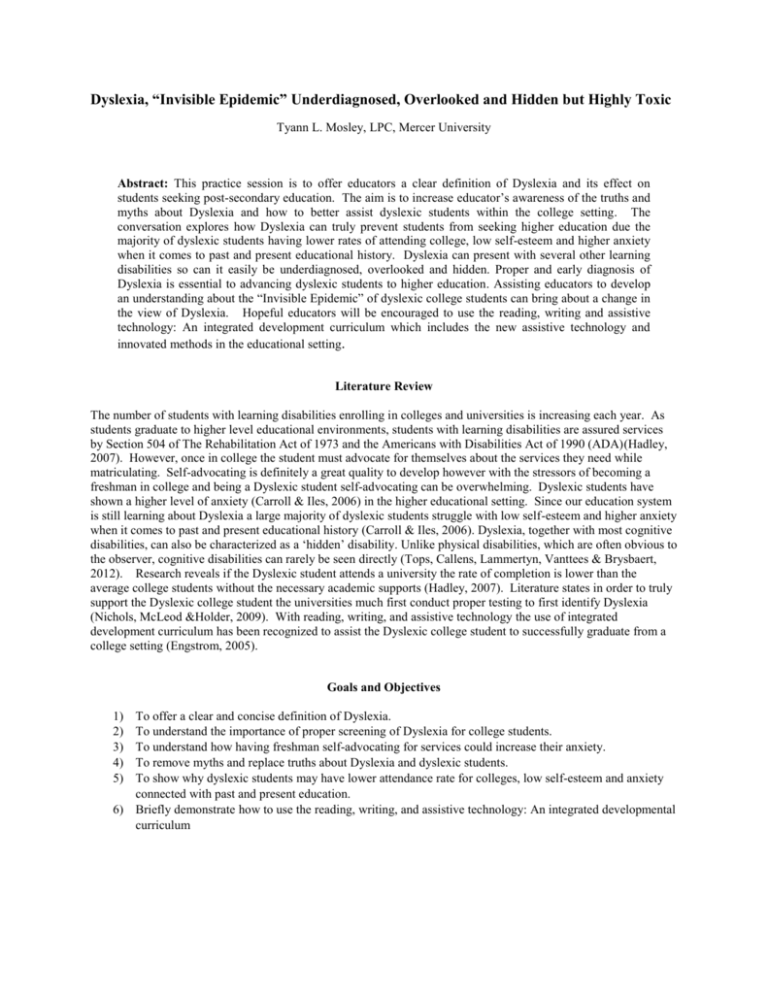
Dyslexia, “Invisible Epidemic” Underdiagnosed, Overlooked and Hidden but Highly Toxic Tyann L. Mosley, LPC, Mercer University Abstract: This practice session is to offer educators a clear definition of Dyslexia and its effect on students seeking post-secondary education. The aim is to increase educator’s awareness of the truths and myths about Dyslexia and how to better assist dyslexic students within the college setting. The conversation explores how Dyslexia can truly prevent students from seeking higher education due the majority of dyslexic students having lower rates of attending college, low self-esteem and higher anxiety when it comes to past and present educational history. Dyslexia can present with several other learning disabilities so can it easily be underdiagnosed, overlooked and hidden. Proper and early diagnosis of Dyslexia is essential to advancing dyslexic students to higher education. Assisting educators to develop an understanding about the “Invisible Epidemic” of dyslexic college students can bring about a change in the view of Dyslexia. Hopeful educators will be encouraged to use the reading, writing and assistive technology: An integrated development curriculum which includes the new assistive technology and innovated methods in the educational setting. Literature Review The number of students with learning disabilities enrolling in colleges and universities is increasing each year. As students graduate to higher level educational environments, students with learning disabilities are assured services by Section 504 of The Rehabilitation Act of 1973 and the Americans with Disabilities Act of 1990 (ADA)(Hadley, 2007). However, once in college the student must advocate for themselves about the services they need while matriculating. Self-advocating is definitely a great quality to develop however with the stressors of becoming a freshman in college and being a Dyslexic student self-advocating can be overwhelming. Dyslexic students have shown a higher level of anxiety (Carroll & Iles, 2006) in the higher educational setting. Since our education system is still learning about Dyslexia a large majority of dyslexic students struggle with low self-esteem and higher anxiety when it comes to past and present educational history (Carroll & Iles, 2006). Dyslexia, together with most cognitive disabilities, can also be characterized as a ‘hidden’ disability. Unlike physical disabilities, which are often obvious to the observer, cognitive disabilities can rarely be seen directly (Tops, Callens, Lammertyn, Vanttees & Brysbaert, 2012). Research reveals if the Dyslexic student attends a university the rate of completion is lower than the average college students without the necessary academic supports (Hadley, 2007). Literature states in order to truly support the Dyslexic college student the universities much first conduct proper testing to first identify Dyslexia (Nichols, McLeod &Holder, 2009). With reading, writing, and assistive technology the use of integrated development curriculum has been recognized to assist the Dyslexic college student to successfully graduate from a college setting (Engstrom, 2005). Goals and Objectives 1) 2) 3) 4) 5) To offer a clear and concise definition of Dyslexia. To understand the importance of proper screening of Dyslexia for college students. To understand how having freshman self-advocating for services could increase their anxiety. To remove myths and replace truths about Dyslexia and dyslexic students. To show why dyslexic students may have lower attendance rate for colleges, low self-esteem and anxiety connected with past and present education. 6) Briefly demonstrate how to use the reading, writing, and assistive technology: An integrated developmental curriculum Discussion To make post-secondary educators aware of how Dyslexia is the “Invisible Epidemic” among college campuses. To disband the myths surrounding Dyslexia focused on the student’s academic ability. To understand the lasting damage of underdiagnosing dyslexia in regards to the student’s desire to further their education along with low selfesteem and anxiety connected with past and present education. To create the necessary educational environment for dyslexic students to successful attend and complete college with the use of the reading, writing and assistive technology: An integrated development curriculum. References Armstrong, D., & Humphrey, N. (2009). Reactions to a diagnosis of dyslexia among students entering further education: Development of the ‘resistance-accommodation’ model. British Journal of Special Education, 95-102. Carroll, J., & Iles, J. (2006). An Assessment of Anxiety Levels in Dyslexic Students in Higher Education. British Journal of Educational Psychology, 651-662. Engstrom, E. (2005). Reading, Writing, and Assistive Technology: An Integrated Developmental Curriculum for College Students. Journal of Adolescent & Adult Literacy, 30-39. Foss, B. (2013). The dyslexia empowerment plan: A blueprint for renewing your child’s confidence and love of learning (1st ed.). The Random House Publishing Group. Habib, L., Berget, G., Sandnes, F., Sanderson, N., Kahn, P., Fagernes, S., & Olcay, A. (2012). Dyslexic students in higher education and virtual learning environments: An exploratory study. Journal of Computer Assisted Learning, 574-584. Kirby, A., Sugden, D., Beveridge, S., Edwards, L., & Edwards, R. (2008). Dyslexia and developmental co‐ordination disorder in further and higher education—similarities and differences. Does the ‘Label’ influence the support given? Dyslexia. Kirby, J., Silvestri, R., Allingham, B., Parrila, R., & La Fave, C. (2008). Learning Strategies and Study Approaches of Postsecondary Students with Dyslexia. Journal of Learning Disabilities, 85-96 Nichols, S., Mcleod, J., Holder, R., & Mcleod, H. (2009). Screening for dyslexia, dyspraxia and Meares-Irlen syndrome in higher education. Dyslexia, 42-60. Mortimore, T., & Crozier, W. (2006). Dyslexia and difficulties with study skills in higher education. Studies in Higher Education, 235-251. Schultz, P. (2011). My Dyslexia. New York: W. W. Norton &Co. 33-38 Tops, W., Callens, M., Lammertyn, J., Hees, V., & Brysbaert, M. (2012). Identifying students with dyslexia in higher education. Annals of Dyslexia, 186-203.
